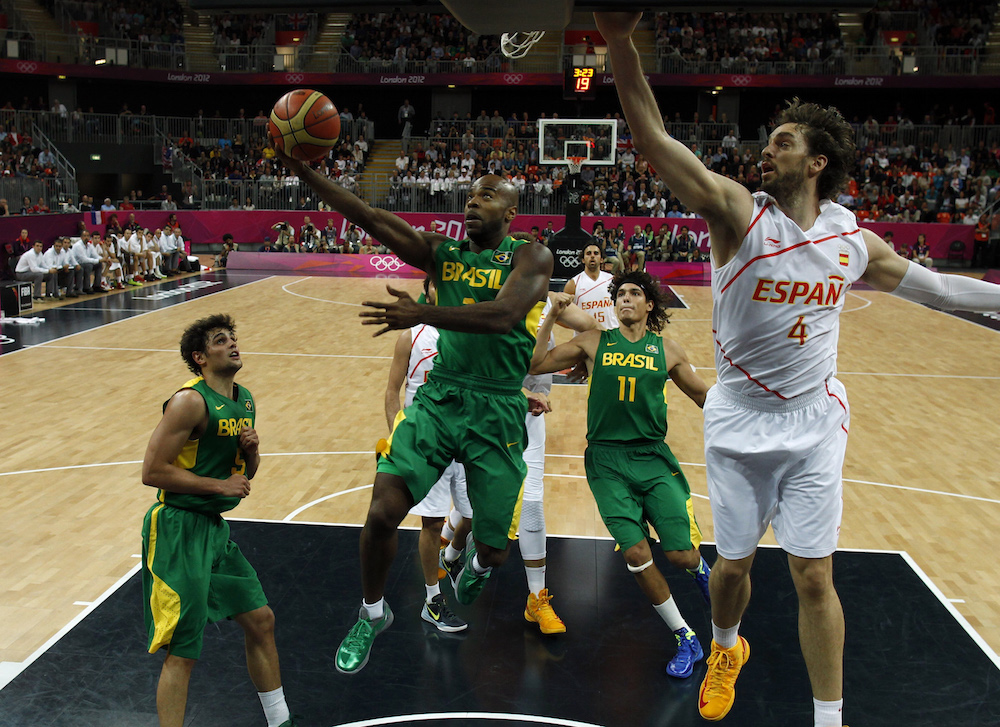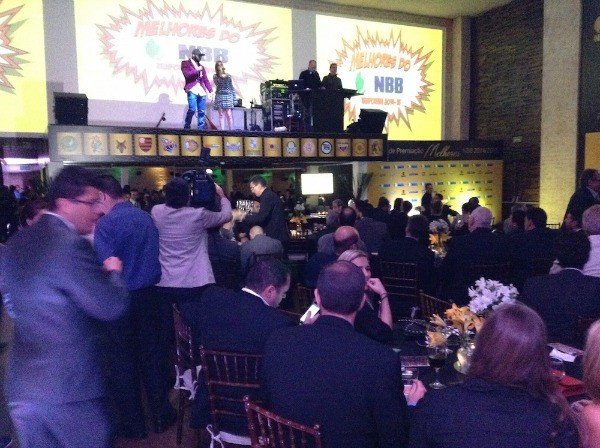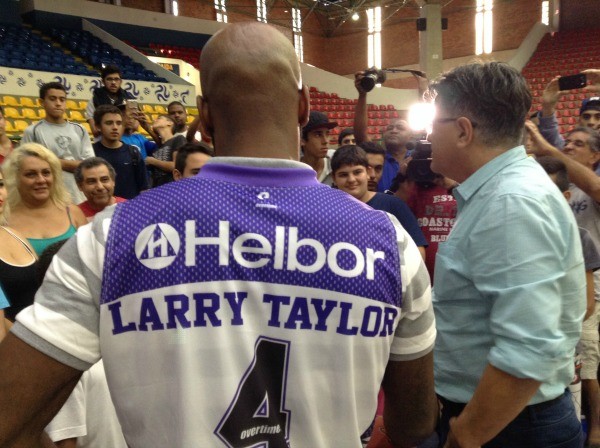
Brazil’s Larry Taylor (C) gets past Spain’s Pau Gasol during their men’s preliminary round Group B basketball match at the Basketball Arena during the London 2012 Olympic Games August 6, 2012. REUTERS/Mike Segar (BRITAIN – Tags: OLYMPICS SPORT BASKETBALL) – RTR36BAJ
During the Brazilian basketball league’s recent all-star ceremony, held at an upscale lounge in São Paulo, Larry Taylor climbed atop a stage and started rapping his new hip-hop single, “Be Who You Are,” before a crowd of several hundred people, including the league president and national team coach. Taylor alone was not wearing a black suit, having opted for a maroon sports jacket, jeans, high-tops, and a flat-brimmed cap.
“Be a freethinker, make your own decision,” the 6-foot-1-inch guard from Chicago rapped in English. “In the midst of a mission just follow your intuition.”
The lyrics could be a personal anthem for the 34-year-old, who in 2008 made the unconventional decision to go play in Brazil’s nascent pro league, known as the Novo Basquete Brasil (NBB), rather than pursuing a career in Europe’s more competitive and higher-paying leagues. The counterintuitive move paid off. Taylor has been a league all-star five times, won consecutive championships in the Americas tournament of the International Basketball Federation, and in 2012 played in the London Olympics for the national team of Brazil, which awarded him citizenship for the occasion. He’s been selected to play again in the 2016 Olympics in Rio de Janeiro.
Taylor is one of thousands of Americans who play basketball professionally abroad, spreading a love of the game into the very heart of the soccer world. Futebol’s incursion into America is such a compelling story it’s easy to forget that our own U.S. sports, basketball especially, are making gains around the world. In a sense, even if he went native, Taylor is a cultural ambassador for American culture.
An unspectacular point guard for a NCAA Division II university in the Midwest, Taylor was unselected in the 2003 draft. Now, he is the one passing on offers to play in the NBA’s development league, the stepping stone to the NBA, so he can stay in Brazil and have a shot at winning an Olympic medal next year.
“I’m living the dream,” Taylor told me, “just further away from home than I thought I would be.”

Taylor at the Brazilian basketball league’s all-star ceremony
Taylor wouldn’t be the first American basketball player to medal for a foreign team. New York native Crawford Palmer won silver playing for France in 2000, and Michael Sylvester of Ohio won silver playing for Italy in 1980. On the women’s side, Rebecca Hammon of South Dakota led Russia’s Olympic squad to bronze at the 2008 Olympics. While there’s criticism every Olympics over teams recruiting (and nationalizing) stars from other countries, the tradition of itinerant American basketball players taking their game overseas is well established. In the 1930s, a Californian named Frank Luben introduced the game to Lithuania and turned the Eastern European nation into a basketball powerhouse, according to sports history professor Christopher Elzey of George Mason University. Luben is still considered a national hero in Lithuania.
Elzey himself played basketball for the University of Pennsylvania and professionally in Europe and Australia in the 1980s and 1990s, just as the 1992 USA Dream Team was captivating audiences and raising the game’s profile overseas.
“What better life than that? To play ball, get paid for it, immerse in the culture,” Elzey told me in a telephone interview. “I saw myself as an ambassador in some ways. Sport has always been that. At this grassroots level, you get this exchange of attitudes and experiences.”
As for Taylor, his journey, following his graduation in 2003 from Missouri Western State and a stint in the semi-pro American Basketball Association (the non-banker, non-lawyer ABA), first took him to Mexico. From there it was off to Venezuela’s pro league, and onto Brazil in 2008.
“I thought it’d be a year-long vacation and I’d play basketball,” Taylor told me. “The only thing I’d seen from Brazil before was Carnival and the beach, all the stuff you see on TV and music videos.” Alas, he landed in Bauru, a small university town and railway hub in the interior of São Paulo state, hundreds of miles from any beach or glamour.
Taylor said he picked up Portuguese quickly and started enjoying Brazil as his success took off. He was having fun: A YouTube video from a 2008 slam dunk contest in Brazil shows him leaping over another player, who is seated in a chair, to catch a ball mid-flight that he dunks, as the crowd erupts. He seems to love being a big fish in a small (if Brazil could ever be called that) pond. During the awards ceremony on June 8, Bauru was called on stage to be awarded for placing second in the Brazilian league and teammates pushed the trophy into Taylor’s hands.
“Larry feels the Brazilian colors,” Rafael Luz, a 23-year-old guard for the national team, told me. “You can see that he really likes the country. He’s not just taking the money and going home. He’s like family to us.” Paulo Prestes, a 6-foot-11-inch forward for the national team, agreed.
Luz and Prestes, unlike Taylor, never thought much of playing in Brazil—until recently. They wanted to play overseas. Prestes, who first touched a basketball in high school, signed a contract at age 17 to play in Spain and in 2010 was drafted in the second round of the NBA draft by the Minnesota Timberwolves, although injuries sent him back to Spain. Luz was sent at age 15 to the development league in Spain, where he’s now pro.

Taylor at the Mogi das Cruzes press conference
But as Brazil’s league matures, it’s attracting more talent. Prestes came home to play in Brazil last year, and Luz is also considering returning, lured by the improved competition and rising salaries. Team payrolls now average $1.3 million, still short of what a single NBA starter would make in a season. Stars in Brazil can make in the neighborhood of $250,000.
Thirty-five foreigners, including 24 Americans, now play in the NBB. Sponsorship money is evident on Brazilian team jerseys, which are so plastered in advertisements that the team name is relegated to a small patch.
“When I got here in 2008 there were a couple good teams and everyone else was so-so,” Taylor said. “And now you have to be ready to play hard every night.”
The day after the awards ceremony in São Paulo, I went with Taylor to the suburb of Mogi das Cruzes. He had opted out of his contract with Bauru because he thought he could win a championship with Mogi das Cruzes, where he’ll be playing alongside his friend Shamell Stallworth, a forward from California who was named the league’s top foreigner this year.
If Mogi das Cruzes does win a championship, I asked, will critics say it was because the team spent heavily to stack itself with foreigners?
“That’s not going to be an issue—the best teams are all stacked,” Taylor said. Several players from Argentina’s national team play together in Rio de Janeiro for Flamengo, and Flamengo had just beat Taylor’s team to win the Brazilian league championship.
Taylor shot a few baskets, finished signing autographs, and sat with me briefly to talk about his career. Hovering beside us was one of his new managers, a heavyset Brazilian with slick hair, who stared at his watch and fidgeted. After 15 minutes, the manager reminded Taylor he still needed to look at new apartment rentals before returning that night to Bauru so he could pack and prepare to move. The interview was over. The demands of Brazilian basketball stardom beckoned.
“It’s another life for Larry,” said Marcio Cipriano, a 6-foot-7-inch Brazilian forward who played alongside Taylor for the national team. “Sometimes you have to change your world to be somebody.”




Send A Letter To the Editors